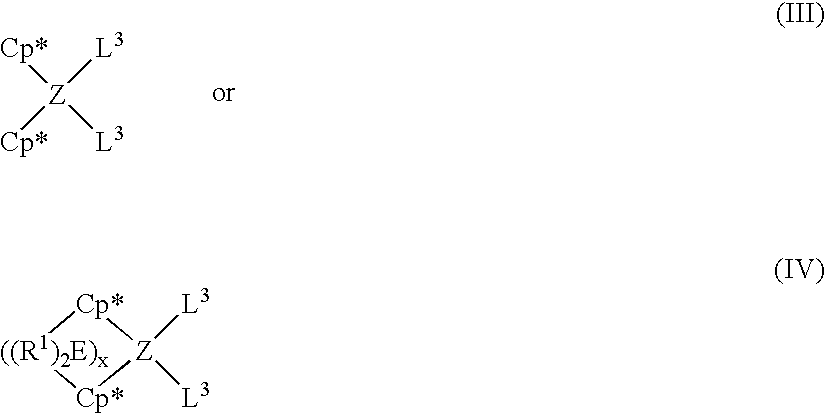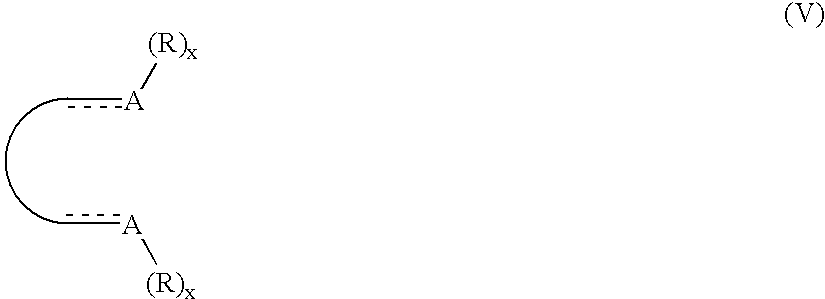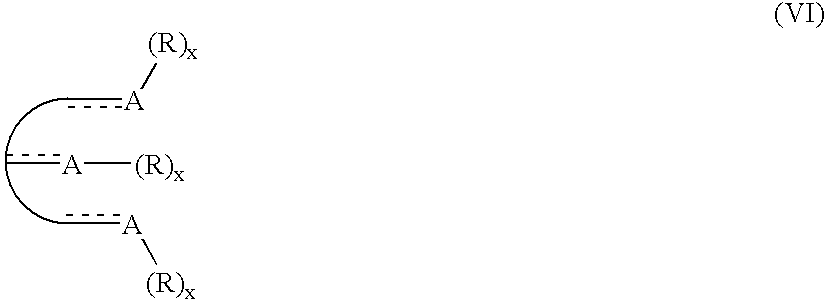[0289]Thus, while activation mechanisms by which conventional coordination catalyst systems operate include, but are not limited to (a) abstraction of at least one L3 group of the Group (1) compounds or at least one L group of the Group (2) compounds by a Lewis acid by an abstracting
moiety such as carbonium, tropylium, carbenium, ferrocenium and mixtures, and (b)
protonation (by a Brønsted acid) of the L3 or L group, when L3 or L constitutes a
hydride or hydrocarbyl (e.g.
alkyl) group, such mechanisms typically require materials additional to the support for implementation. The same is not true for the present invention. It is a particular
advantage of the present invention that such conventional ionizing agents used to produce ionic catalysts can be eliminated and replaced with the support-activator agglomerate of the present invention which performs the
dual function of activation and supporting agent.
[0290]From a practical standpoint, it is preferred that L3 of the Group (1) compounds or L of the Group (2) compounds be
halogen, e.g., Cl, in the pre-catalyst. This stems from the fact that when L3 or L is
halogen (highly
electron withdrawing) the pre-catalyst is very stable and can easily be transported. However, because L3 or L in this instance is highly
electron withdrawing, it may be more difficult to induce activation thereof by the support-activator agglomerate. Thus, as indicated above, it is possible to pre-activate the pre-catalyst, by replacement of the halogens constituting L3 or L with less
electron withdrawing groups such as hydrocarbyl groups, e.g.,
alkyl groups, using organometallic compounds. The particular point in time when the organometallic compound contacts the pre-catalyst is at the option of the manufacturer and can be (a) before, during or after contact of the support-activator agglomerate with pre-catalyst prior to entry into the
polymerization zone and / or (b) upon or during
polymerization by direct addition to the polymerization zone. However, because pre-activated catalysts are less stable than the halogenated precursors thereof, organometallic compound addition, when employed, is preferably conducted in the presence of the support-activator agglomerate. It is a further particular
advantage of the present invention that activation of the pre-catalyst (having L=
halogen) can be delayed by avoiding the use of the organometallic compound to induce pre-activation until polymerization occurs. Thus, such pre-catalyst can be impregnated into / onto the support-activator agglomerate and the same recovered without activation until used for polymerization. When employing lower amounts of organometallic compound, such compound can be added to the reactor during polymerization.
[0291]Accordingly, one preferred embodiment comprises using pre-catalyst wherein each L3 group of the Group (1) compounds or each L group of the compounds of Formula X or XI of the Group (2) compounds is a halogen atom. In this embodiment the pre-catalyst and support-activator agglomerate are separately mixed. In another embodiment said pre-catalyst, support-activator agglomerate and at least one organometallic compound (represented by Formula XVII below) as a
scavenger and / or alkylating agent are admixed simultaneously prior to polymerization. In this embodiment, at least one of the halogens constituting L3 or L becomes a new hydrocarbyl L3 or L group derived from the organometallic compound during pre-activation. More specifically, when used as a
scavenging and alkylating agent, the organometallic compound is typically added directly to the polymerization zone, whereas when employed as an alkylating agent alone it is desirably added to the mixture of support-activator agglomerate and pre-catalyst. Organometallic compounds suitable for use in pre-activation include those represented by formula (XVII): M(R12)s XVII
[0292]wherein M represents an element of the Group 1, 2 or 13 of the
Periodic Table, a
tin atom or a
zinc atom; each R12 independently represents a
hydrogen atom, a halogen atom, hydrocarbyl, typically C1 to C24 hydrocarbyl, including C1 to C24
alkyl or alkoxy and
aryl, aryloxy, arylalkyl, arylalkoxy, alkylaryl or alkylaryloxy group having 6 to 24 carbon atoms (such as a
hydrogen atom, halogen atom (e.g.,
chlorine,
fluorine,
bromine,
iodine and mixtures thereof), alkyl groups (e.g., methyl, ethyl, propyl, pentyl, hexyl, heptyl, decyl,
isopropyl, isobutyl, s-butyl, t-butyl), alkoxy groups (e.g., methyoxy, ethoxy, propoxy, butoxy, isopropoxy),
aryl groups (e.g., phenyl,
biphenyl, naphthyl), aryloxy groups (e.g., phenoxy), arylalkyl groups (e.g., benzyl, phenylethyl), arylalkoxy groups (benzyloxy), alkylaryl groups (e.g., tolyl, xylyl, cumenyl, mesityl), and alkylaryloxy groups (e.g., methylphenoxy). For Group (1) and Group (2) compounds when at least one L3 or L, respectively, is non-hydrocarbyl, preferably at least one R12 is hydrocarbyl, e.g., an alkyl group having 1 to 24 carbon atoms or an
aryl, arylalkyl or alkylaryl group having 6 to 24 carbon atoms, e.g., to provide a source of hydrocarbyl groups for
alkylation of the pre-catalyst. In each instance, “s” is the oxidation number of M.
[0293]The preferred organometallic compounds are those wherein M is aluminum. Representative examples of organometallic compounds include alkyl aluminum compounds, preferably trialkyl aluminum compounds, such as trimethyl aluminum, triethyl aluminum, triisopropyl aluminum, trlisobutyl aluminum, tri-n-propylaluminum, triisobutylaluminum, tri-n-butylaluminum, triamylaluminum, and the like; alkyl aluminum alkoxides such as ethyl aluminum diethoxide, diisobutyl aluminum ethoxide, di(tert-butyl) aluminum butoxide, diisopropyl aluminum ethoxide, dimethyl aluminum ethoxide, diethyl aluminum ethoxide, di-n-propyl aluminum ethoxide, di-n-butyl aluminum ethoxide, and the like; aluminum alkoxides such as aluminum ethoxide, aluminum propoxide, aluminum butoxide and the like; alkyl or aryl aluminum halides such as diethyl aluminum
chloride, ethyl aluminum dichloride, diisopropyl aluminum
chloride and the like; aluminum aryloxides such as aluminum phenoxide, and the like; and mixed aryl, alkyl or aryloxy, alkyl aluminum compounds and aluminum hydrides such as dimethylaluminum
hydride, diethylaluminum
hydride, diisopropylaluminum hydride, di-n-propylaluminum hydride,
diisobutylaluminum hydride, and di-n-butylaluminum hydride. The most preferred organometallic compounds are the trialkyl aluminum compounds. When at least one L3 of the Group (1) transition metal compounds or at least one L of the Group (2) transition metal compounds is halogen, the pre-catalyst and / or the organometallic compound can be mixed in a
diluent, preferably an
inert diluent, prior to, simultaneously with, or after contact (of either one) with the support-activator agglomerate. The pre-catalyst, when two L groups of either Group (1) or Group (2) are halogen, is stable to materials which are poisons to the activated catalyst.
[0294]In a second preferred embodiment wherein in the pre-catalyst each L3 of a Group (1) compound (or material) or L of a Group (2) compound (or material) is a hydrocarbyl, a hydrocarbylene or a hydrocarbyloxy group, there is no need for the addition or handling of the organometallic compound. Thus, the catalyst composition can be readily formed and used without pre-activation. However, even in this instance, it is still preferred to employ at least some organometallic compound as a
scavenger during polymerization to deactivate potential poisons to the activated catalyst.
 Login to View More
Login to View More 


